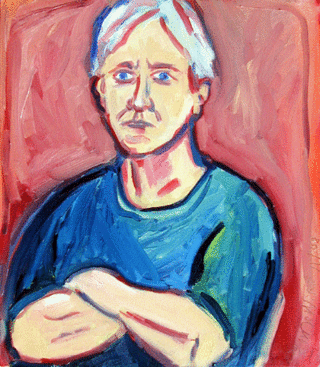Intelligence
Depth Psychology of Art
Art expression helps us break the surface and dive into our deepest depths.
Posted May 12, 2016

It's a pleasure and an honor to bring Psychology Today readers a second interview with expressive arts therapy icon Shaun McNiff. This post focuses on the depth psychology of art and McNiff's thoughts and perspectives about the transformational "intelligence" of artistic expression in health and well-being.
In this time of activity-driven approaches, interventions and evidence-based protocols, how do we help individuals not only find reparation, but also find wellness through exploring the deeper terrain within the human experience? According to Shaun McNiff, the arts are one pathway and the media of depth psychology. His seminal book, Depth Psychology of Art, written nearly thirty years ago, reminds us that art making is not only a manifestation of the psyche, it is also "a deep and psychologically intelligent process" that occurs with spontaneity and surprisingly transformative outcomes. And paradoxically, as McNiff notes, depth is also on the surface of creation, a more immediate reflection of what is often unseen and unappreciated within the self.
This interview begins with the following definition: Depth psychology most often refers to approaches to therapy that are open to the exploration of the subtle, unconscious, and transpersonal aspects of human experience.
Yes, a common feature in every definition of depth psychology, no matter what the school of thought, is the primacy of processes that happen outside conscious awareness and thus the close relationship to artistic expression that often acts beyond and sometimes in spite of our more direct intentions, thoughts, and perceptions. Subtle is a good word, suggesting that we can pay closer attention. For me depth is paradoxically on the surface of life and art---unseen and unappreciated and always in process. When we think that the depths are buried somewhere and hidden, using analytic thinking like an excavator digging away, we avoid the depth of immediate things, the present moment inviting us to respond with more awareness, spontaneity, and imagination.
Is there an intersection between the arts and depth psychology as ways of exploring human experience?
The arts integrate what happens inside and outside conscious thought, the visible and invisible acts of creating. So yes, there is an intersection and I feel that the arts are media of depth psychology. Dreams are too and they have been a primary feature of the tradition but the arts are wide awake activities; they are what we use to access and give tangible form to Psyche’s wisdom, complexity, and depth.
Going deep has to be personal, a combination of subjective and objective experience. This is another intersection, as you call it, which is unique to art. Jung said the personal is the opening to the “objective psyche.” The banishing of the personal, the intimate basis of artistic expression, eliminates depth.
How did you discover the arts as a pathway to exploring your own “depths?”
Having the opportunity to work with others in expressing their souls, passions, needs, afflictions, and joys through art has been a reliable way of paradoxically discovering what you describe as my own depths. I discover and know myself through others, and the others of their art and my art.
In my personal artistic practice I experience how artistic expression transforms the most difficult and troublesome things using their energy to create; as you have said, it fosters resilience----rather than simply manifesting the problems, it does something with them that only art can do. This is a deep and psychologically intelligent process that always happens outside my plans and controls. It is what I have called a force of Nature, the “transpersonal” aspect that you mentioned in your first question, and it is pretty wondrous, another feature perhaps of depth psychology.

In your book Depth Psychology of Art, you re-visioned the term “interpretation” when it comes to how artistic expression is defined and categorized. How did this re-vision come about and have you “revised your re-vision” in the 21st century?
Depth Psychology of Art was written nearly thirty years ago and it presents the equivalent of an historical literature review on the sources that have informed my positions. I find it useful today because those things do not change. Perhaps the only major thing that I would add to that review is my re-connection to the work of my college teacher Thomas Berry whose sacred earth thinking in The Great Work and other books offers a comprehensive cosmology of depth, imagination, and creation.
The issue of art interpretation has been a bedrock for me since I started to work with art in mental health. Ironically, my most formative influence has been observing how not to do art interpretation. I was appalled in 1970 with how artistic expressions were labelled with idiosyncratic concepts and used in diagnostic drawing tests that continue to this day whereby everything people express is seen as manifesting some form of psychopathology. It has mobilized me to not just challenge the practices but offer something different and positive. When the assumption is that an artistic expression is to be rationally explained, this immediately replaces its depth, complexity, and as I say above, its otherness, with someone’s concept. The way of depth involves the discipline of establishing a more compassionate relationship with the image whereby we do our best to witness the expression, suspend judgment, open and respond to its presence. Interpretation is an ongoing process of connecting as with another person. It keeps the image alive.
Do you see this depth in art therapy today?
There are many people like you doing things worldwide that create a community of depth and imagination. As always there are movements toward superficiality. I have been taken aback by the appearance of coloring books, something that I never would have imagined in a field where even the most conservative strains of the work have always emphasized spontaneous expression, but as a diagnostic way of manifesting so-called pathological contents as I described. At least all of us were once together in encouraging free expression, albeit guided by contrasting goals and paradigms.
Art therapy has always been permeated by unsettling things that activate my advocacy for a deeper understanding of the artistic process, how it heals and furthers human understanding wherever in the world people have access. I thank the agitations for giving me a direction and a voice.
You have been on the forefront of what is now commonly known as “arts-based research.” For readers who are unfamiliar with this concept, can you briefly explain how the arts can be a way of knowing, particularly in contrast to the standard science-driven paradigms of investigation and inquiry?
I define art-based research as the researcher’s use of personal artistic expression, alone or with others, as a primary mode of inquiry. The most fundamental rationale is the same as the one justifying its use in therapy as a way of knowing, how the image and the process of making it are a few steps ahead of the reflecting mind. Almost always, discovery and meaning emerge unplanned through the process and we then reflect upon it all. There is an intelligence in the process that operates beyond linear thought and language, so why is it that disciplines based upon these principles do not use them as a basis of research? It relates to legitimacy issues and feeling the need to justify oneself according to the socially accepted and dominant paradigm. There are many questions and uses of the arts that are more suited to artistic inquiry. I am particularly interested in research that perfects methods of practice---how can I ask other people to do things that I have not done myself?
Since art-based research corresponds to the process of making art, you cannot know the end at the beginning and the methods will be infinitely variable, like art, and individually designed in response to questions and the goals of the research. The best things tend to happen spontaneously. These open-ended and personal possibilities are the opposite of analytic science and in my view a complement to it.
Many schools require the use of fixed social science methods that churn out studies that reiterate the approved formats and are permeated with scientism and jargon that approaches art as data to be analyzed. You know how data oriented I am in certain aspects of life where it is appropriate but I cannot call art data; it takes away the significance and mystery. Artistic expressions are the evidence in our discipline--- how can we present them in convincing ways that look, sound, and feel like the work, inspire others, and impact future practice.
How would you respond to the following statement— The mystery of imagination is present in dream and vision, in disease and health, in personal and collective unconscious. The arts are both a manifestation of the imagination of the individual and of the culture.
James Hillman, who felt that imagination is the primary intelligence that needs to be educated and cultivated, said to me in an 1986 interview that he supports art therapists with all of his heart because “they could really be the carriers of imagination into the culture at the grassroots level. They have access that artists themselves don’t have and that psychologists have wasted.” I think he would appreciate your statement and say yes, yes, and yes. We might ask ourselves today how well we are doing in bringing imagination to the world, spreading it as much as possible rather than restricting access. How can we lead and foster a more inclusive participation. An important step might be for our training programs, associations, and journals to accept these questions as a basis of our mission.
[If you missed the previous Psychology Today interview with McNiff, please see Imagination in Action at this link]
Be well,
Cathy Malchiodi, PhD
www.trauma-informedpractice.com
Depth Psychology of Art by Shaun McNiff available at Amazon. You can also read more about McNiff and view a gallery of his work at his website at http://www.shaunmcniff.com.




